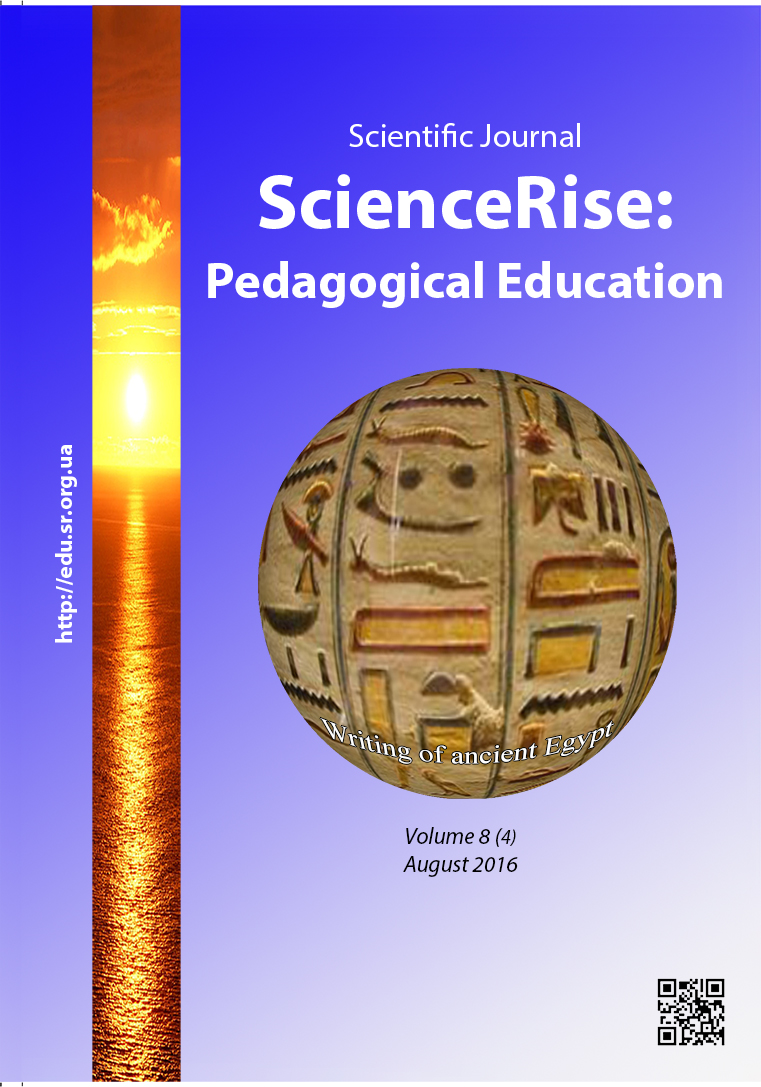Analysis of the psycholinguistic features of teaching japanese academic productive speaking activity
DOI:
https://doi.org/10.15587/2519-4984.2016.76649Keywords:
Speaking, writing, generation, perception, Japanese-language-students, teaching, academic, productive, skills, psycholinguisticAbstract
ThearticlecontainsanalysisoftheworksofUkrainianandforeignscientistsinpsycholinguisticswhereareconsideredthefeaturesofprocessesofgenerationandperceptionofspeakingandalsoinlinguodidacticsthatdealswithteachingforeignlanguageforacademicpurposes. For improving the process of teaching Japanese language for academic purposes in the article were elucidated the psycholinguistic features of processes of generation and perception of academic Japanese productive speaking, namely: talking and writing and on this base there were determined skills that must be developed at teaching Japanese academic speaking within the courses of Japanese language for MA students. It was elucidated, that Japanese academic speaking and writing have several specific features, without considering which it is impossible to master Japanese speaking style. It was also proved, that hieroglyphic graphics in Japanese language complicates the learning process moreReferences
- Kolesnikova, N. I. (2010). Chto vazhno znat o yazyke i stile nauchnyh tekstov? Vysshee obrazovanie v Rossii, 3, 130–137.
- Korotkina, I. B. (2013). Akademicheskoe pismo: na puti k kontseptualnomu edinstvu. Vysshee obrazovanie v Rossii, 3, 137–142.
- Nuzha, I. V., Schemelyova, I. Y. (2013). Vestnik Severnogo (Arkticheskogo) federalnogo universiteta. Seriya: Gumanitarnye I sotsialnie nauki, 5, 113–121.
- Smirnova, N. V. (2015). Akademicheskaya gramotnost I pismo v VUZE: ot teorii k praktike. Vysshee obrazovanie v Rossii, 6, 58–64.
- Kvasova, O. G. (2012). Going for Degree. Professional English for Students of Linguistics. Kyiv: Lenvit, 167.
- Yahontova, T. V. (2002). Osnovy anglomovnogo naukovogo pysma. Lviv: Vydavnychyi tsentr LNU im. I. Franka, 220.
- Sazanovych, L. V. (2014). Formuvannya navychok akademichnogo pysma na zanyattyah z angliyskoi movy v medychnomu VNZ. Pedagogika formuvannya tvorchoi osobystosti u vischiy I zagalnoosvitniy shkolah, 34 (87), 504–509.
- Vygotskiy, L. S. (1956). Izbrannye psihologicheskie issledovaniya. Myshlenie I rech. Moscow: APN RSFSR, 519.
- Luriya, A. R. (2002). Pismo I rech. Neirolingvisticheskie issledovaniya. Moscow, 352.
- Zhynkin, N. I. (1964). O kodovyh perehodah vo vnutrennei rechi. Voprosy yazykoznaniya, 6, 26–38.
- Leontiev, A. A. (1981). Psihologicheskie edinitsy porozhdeniya rechevyh vyskazyvaniy. Moscow: Nauka, 307.
- Zimnyaya, I. A. (1991). Psihologiya obucheniya inostrannym yazykam v shkole. Moscow: Prosveshhenie, 223.
- 国際交流基金日本語教授法シリーズ第6巻「話すことを教える」. 、ひつじ書房、東京、[Japan Foundation. Series of the textbooks about how to teach Japanese Language] Vol. 6 (2009). How to teach Speaking in Japanese Language. Hitsuji Publishing Company, Tokyo, 105.
- 国際交流基金日本語教授法シリーズ第8巻「書くことを教える」、.ひつじ書房、東京、[Japan Foundation. Series of the textbooks about how to teach Japanese Language] Vol. 8 (2010). How to teach Writing in Japanese Language. Hitsuji Publishing Company, Tokyo, 124.
- 国際交流基金日本語教授法シリーズ第13巻「教え方を改善する」、[Text] 格式会社ひつじ書房、東京、[Japan Foundation. Series of the textbooks about how to teach Japanese Language] Vol. 13 (2010). How to improve Japanese Language teaching methods. Hitsuji Publishing Company, Tokyo, 96.
- Asadchih, O. V., Smovzhenko, L. G. (2015). Metodyka formuvannya movlennevyh kompetentnostei: teoriya ta praktyka (na materiali shidnyh mov). Kyiv: Vydavnychyi Dim Dmytra Burago, 192.
- Sudzuki, K. (2004). 鈴木克明『教材設計マニュアル』. 北大路書房 [Manual of design of teaching materials]. Hokudairo Publishing Company, 188.
- Okadzaki, H., Okadzaki, T. (2001). 岡崎眸、岡崎敏雄『日本語教育における学習の分析とデザイン「言語習得過程の視点から見た日本語教育」』. 凡人社 [Analysis and Design of learning in Japanese Language Education. View on Japanese Language Education throw the process of language acquisition]. Bonjinshya Publishing Company, 191.
- Zagnitko, A. P., Dormacheva, I. R. (2001). Osnovy movlennevoi diyalnosti. Donetsk: Ukrainskyi kultorologichnyi tsentr, 56.
- Coates, J. (2003). The role of epistemic modality in women’s talk. Modality in Contemporary English, 331–348. doi: 10.1515/9783110895339.331
Downloads
Published
How to Cite
Issue
Section
License
Copyright (c) 2016 Оксана Висилівна Асадчих

This work is licensed under a Creative Commons Attribution 4.0 International License.
Our journal abides by the Creative Commons CC BY copyright rights and permissions for open access journals.
Authors, who are published in this journal, agree to the following conditions:
1. The authors reserve the right to authorship of the work and pass the first publication right of this work to the journal under the terms of a Creative Commons CC BY, which allows others to freely distribute the published research with the obligatory reference to the authors of the original work and the first publication of the work in this journal.
2. The authors have the right to conclude separate supplement agreements that relate to non-exclusive work distribution in the form in which it has been published by the journal (for example, to upload the work to the online storage of the journal or publish it as part of a monograph), provided that the reference to the first publication of the work in this journal is included.








